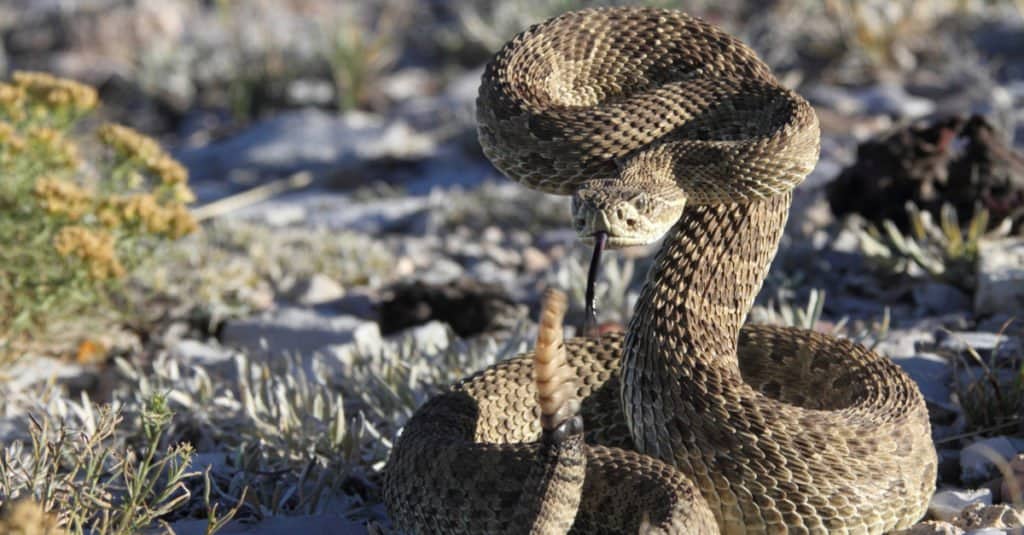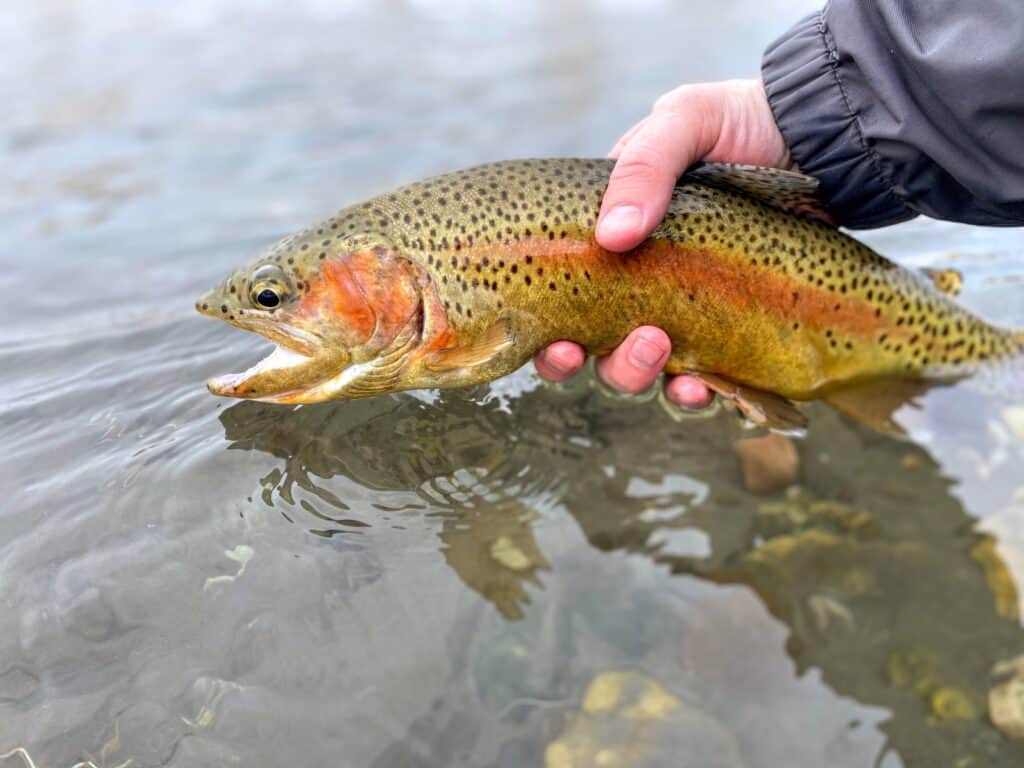Have you ever longed to escape away from civilization? Have you ever wanted to disappear into the wilderness and explore a place where very few people have ever gone? If so, you are not alone. Today, roads and human development have reshaped the vast land of the United States. However, there are still places untouched by human development. These are often places where you can see the starry skies at night, see rare and unusual wildlife in their natural habitat, or simply enjoy the peace and beauty of nature. This article is all about discovering the most remote spot in the United States: a little-known part of Yellowstone National Park in Wyoming. Together, let’s define the “most remote” spot in the U.S., discover what makes it so unique, and learn all about Yellowstone National Park. Let’s go!

©Jess Kraft/Shutterstock.com
How to Determine the Most Remote Spot in the U.S.
Defining Remoteness
Where is the most remote spot in the United States? Well, first you have to start by defining the term “remote.” According to the Means family, including scientists Ryan and Rebecca Means, the most remote spot in the U.S. must be defined quantitatively. When the two set out to visit the most remote spot in every state, and eventually the most remote spot in the entire country, they needed to create a measurement that could be consistent. Eventually, the two decided that “remote” would mean “the furthest distance from a road or town.” However, that introduced more layers of complexity. For example, how do you define what is a “road”? Does it have to be paved or can it be gravel? Must it be public or can it be on private land?
Ultimately, Ryan and Rebecca decided that a road could be paved or unpaved, public or private. They also determined that a “remote spot” could not be a flood plain or a location in the center of a lake. It had to be “high and developable.”
Depending on the definition you choose, you may come up with an alternative location. In fact, there is disagreement over which exact coordinates could be called “the most remote.” The place described in this article is based on Ryan and Rebecca’s definition and calculations.
Data-Based Calculations
The most remote spot in the U.S., according to Ryan and Rebecca Means, used data from state authorities. By plotting public roads onto a map, they then calculated coordinates to find the place furthest from them, double-checking the results using sources like Google Earth. In the process, the couple has learned that truly remote spots are very rare in the U.S. This has convinced them of the importance of actually undisturbed wilderness and an understanding of how roads impact ecology.
Where is the Most Remote Spot in the U.S.?
According to the Means family, the most remote spot in the 48 mainland continental U.S. states is the most remote spot in Wyoming. The location furthest from the road is inside Yellowstone National Park in Wyoming. In total, this spot is 21.7 miles away from the closest road. However, as far as that might sound, getting there without having road access is even more of a journey. When the Means family visited, their trip to get to the most remote spot required a week-long hike to get there and back. In total, they hiked 75 miles of terrain to reach the remote location on foot without the benefit of roadways or an established hiking route.
However, if you do want to visit, you might need to think twice. The Means family will not reveal the exact coordinates. They do not want the spot to be disrupted by visitors or entrepreneurs. If you want to find the exact place, you will have to go through the same level of painstaking data analysis that they did. Alternatively, you can trust the expert analysis of another geologist, who tracks the most remote location to deep within the southeastern part of Yellowstone National Park. While the Means family does not reveal the exact location they visited using GPS, this calculation comes from a geographer named Shawn Lanning at the University of Wyoming. According to Lanning, this remote area is reachable only by hiking and camping through Yellowstone.

©Marina Poushkina/Shutterstock.com
About Yellowstone National Park
The most remote place in the continental U.S. is in Wyoming inside Yellowstone National Park. Yellowstone is not only the first national park of the U.S. but one of the most unique. Founded on March 1, 1872, Yellowstone is full of unique geologic elements like craters and mountains and hydrothermal activity, with geysers and bubbling hot springs. The majority of Yellowstone is in the northwest corner of Wyoming, with smaller portions in both Montana and Idaho.
Yellowstone contains about half of the world’s active geysers, and the park itself is the core of the Greater Yellowstone Ecosystem. This ecosystem encompasses 28,000 square miles, making this part of the world one of the most important intact temperate-zone ecosystems in the world. The unique landscape of Yellowstone was shaped by volcanic activity, geysers, earthquakes, and glaciers. Hydrothermal features also help create a unique habitat in which many microscopic organisms thrive, alongside abundant plants and diverse wildlife species, including mammals, reptiles, amphibians, and birds.

©Peter Kotoff/Shutterstock.com
Remote Parts of Yellowstone National Park
The most remote part of the U.S., which sits inside Yellowstone, is the place you can go to get the farthest away from human development. Since most experts trace this location to the southeastern corner of Yellowstone, visiting the most remote spot in the U.S. will require a trip to the National Park. However, trying to visit is not a simple matter. By definition, choosing a place over 20 miles away from a road means hiking to and from the destination. You will have to walk, carry gear, and camp your way there.
Even though over three million people visit Yellowstone every year, very few will ever get to such a remote area. The more you travel away from human habitation and roads, the more you enter territory that belongs to wildlife animals. In Yellowstone, that includes multiple large predators, including two species of bears, mountain lions, coyotes, and wolverines. Traversing Yellowstone’s “backcountry,” as this wilderness area is called, also requires preparation.
You will need to carefully treat all of your drinking water to avoid getting sick. You will need to pack in order to prevent hypothermia and prepare for potentially dangerous weather. Since there are many insects, you must plan to prevent and treat tick and mosquito bites. Additionally, of particular importance is having an experienced trail guide and taking precautions to avoid getting lost. Lastly, you should be prepared for the wide range of wildlife species you may encounter. Let’s cover these next.
Wildlife in Yellowstone National Park
Within Yellowstone National Park’s land and waters live about 300 species of birds. There are 16 different species of fish. The park is home to five species of amphibians, six species of reptiles, and 67 species of mammals. This means that if you visit, bring your binoculars! There will be ample wildlife viewing opportunities. However, remember to stay at a safe distance can allow you to enjoy many different animal species in real life.
Mammals in Yellowstone
In fact, Yellowstone has the highest concentration of mammals in the continental 48 states of the U.S. In addition to small animals like squirrels, badgers, martens, rabbits, raccoons, and many more, Yellowstone is notable for having eight ungulate species. Ungulates are hooved herbivores. There are two types: even-toed and odd-toed. All of the native ungulates found in Yellowstone are even-toed, though you may also see an odd-toed undulate in the park: horses. The native even-toed undulates in Yellowstone are bighorn sheep, bison, elk, moose, mountain goats, mule deer, pronghorn, and white-tailed deer.
Yellowstone is also home to seven different large predator species. These are black bears, Canada lynx, coyotes, grizzly bears, mountain lions, wolverines, and wolves. These are some of the over a dozen carnivore species in Yellowstone, which also include weasels, river otters, and red foxes.
In addition to these, rodents play a unique and important role in Yellowstone’s ecosystem. On a basic level, they are an important food source for many predators! Yellowstone’s rodent species include beavers, chipmunks, pocket gophers, voles, and squirrels.

©Roy Nelson/Shutterstock.com
Birds in Yellowstone
Scientists have recorded almost 300 species of birds in Yellowstone, 150 of which build their nests in the park itself. These different species include raptors, songbirds, shorebirds, and waterfowl. If you visit, look out for various species of gulls and terns, the common loon, pelicans and great blue herons, turkey vultures, hawks and eagles, owls, kingfishers, woodpeckers, falcons, flycatchers, shrikes, vireos, jays, magpies, crows, ravens, larks, swallows, chickadees, wrens, dippers, kinglets, thrushes, catbirds, starlings, waxwings, and pipits.

©iStock.com/mtnmichelle
Reptiles in Yellowstone
Six confirmed reptile species live in Yellowstone: the bullsnake, the prairie rattlesnake, the rubber boat, the sagebrush lizard, the common garter snake, and the terrestrial garter snake. Right now, none of these reptiles are threatened or endangered. However, there is space for much more research and learning about the animals that play an important role in this high-elevation area in the western U.S.

©Harris Motion Photo/Shutterstock.com
Native Fish in Yellowstone
11 native fish species and 5 non-native fish species live in the waters that flow through Yellowstone. When the park was first established in the 1800s, many of its waters were fishless. Until the 1950s, the park waters were stocked with both native and non-native fish. However, this practice fundamentally changed the ecology of Yellowstone because the non-native fish began displacing or interbreeding with the native fish. Since then, many restrictions have been put in place to support native fish in recovering – and starting in 2001, regulations required all native fish caught in Yellowstone to be returned to the water.
Today, Yellowstone’s waters include the native species of arctic grayling, cutthroat trout (Yellowstone and Westslope), mountain whitefish, longnose dace, speckled dace, redside shiner, Utah chub, longnose sucker, mountain sucker, Utah sucker, and mottled sculpin.
The non-native species of brook trout, brown trout, lake trout, lake chub, and rainbow trout also swim in Yellowstone waterways.

©Ryan Cuddy/Shutterstock.com
Up Next:
"spot" - Google News
July 03, 2023 at 01:17AM
https://ift.tt/n4IjwSQ
The Most Remote Spot in the United States is Truly Spectacular - AZ Animals
"spot" - Google News
https://ift.tt/OGgSAeD
https://ift.tt/d01WMgU
Bagikan Berita Ini


















0 Response to "The Most Remote Spot in the United States is Truly Spectacular - AZ Animals"
Post a Comment